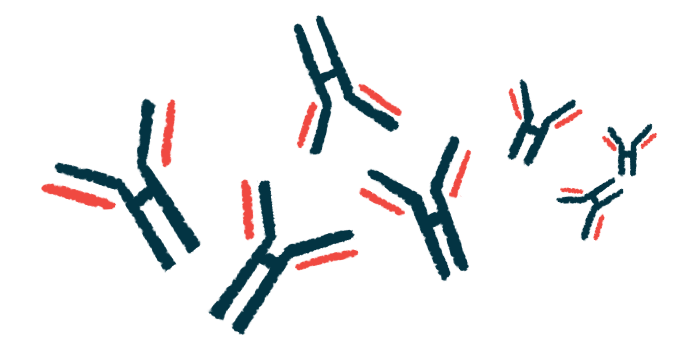Cryptic protein fragments may detect ALS in early stages: Study
Protein could be biomarker for finding ALS, FTD before symptoms appear

A biomarker test that identifies abnormal protein fragments called cryptic peptides may help detect amyotrophic lateral sclerosis (ALS) and frontotemporal dementia (FTD) in the early stages, a study found.
Cryptic peptides from the HDGFL2 protein were elevated in fluid samples from people with ALS/FTD, including in those who had disease-causing mutations but no evident symptoms, according to the study, “A fluid biomarker reveals loss of TDP-43 splicing repression in presymptomatic ALS–FTD,” published in Nature Medicine.
“We believe we’ve discovered a biomarker that could potentially be used to detect ALS and FTD in their earliest stages — even before symptoms appear,” Philip Wong, PhD, professor at Johns Hopkins University School of Medicine and the study’s senior author, said in a university press release.
The team is collecting samples from ALS and FTD patients around the world to continue evaluating their approach and moving it toward the clinic.
“We hope to support the effectiveness, reliability, and sensitivity of our biomarker by testing it on thousands of patient samples, and once validated, encourage its use as a clinical tool,” said the study’s first author, Katie Irwin, a graduate student at Johns Hopkins.
Protein accumulates where it shouldn’t
Toxic accumulation of the TDP-43 protein is evident in most ALS cases and is believed to contribute to nerve cell damage. While the protein is usually found in the cell’s nucleus, the core where DNA is contained, TDP-43 aberrantly clumps outside the nucleus in ALS and FTD.
TDP-43’s usual role is to help in the proper formation of messenger RNA (mRNA), a genetic template produced when the information in DNA is being used to make a protein.
When the protein wrongly accumulates where it shouldn’t, this process becomes corrupted. Some mRNA templates will contain problematic sequences called cryptic exons, which affect the production of proteins important for brain health.
Because the presence of these cryptic sequences in some proteins reflects TDP-43 dysfunction, the researchers had the idea that protein fragments (peptides) containing them could be possible biomarkers of the early stages of ALS or FTD.
Prior to this study, TDP-43 pathology could only be seen during a postmortem tissue analysis, so it wasn’t known to what degree these types of abnormalities might be seen early on.
Pathogenic mechanisms often begin years before the emergence of clinically relevant symptoms.
The team sought to develop antibodies that could bind to cryptic sequences in a blood or spinal fluid sample and be visualized in the lab. They decided to focus on the one protein that seemed the most reliable: HDGFL2.
“Of all the cryptic peptides for which we made … antibodies, the one that worked best was the one designed for the cryptic HDGFL2 protein,” Irwin said. “We used that … antibody to develop an extremely sensitive detection test for the cryptic HDGFL2 protein in body fluids.”
The researchers evaluated their approach by measuring levels of cryptic HDGLF2 in cerebrospinal fluid (CSF) — the fluid surrounding the brain and spinal cord — and blood samples from people with familial ALS/FTD caused by mutations in the C9orf72 gene, sporadic ALS/FTD without any known mutations, and presymptomatic patients with mutations in C9orf72.
Cryptic HDGLF2 was detectable across all patient groups in both types of bodily fluids, including in those who did not yet have any symptoms of the disease. Samples from all ALS/FTD patients had higher levels of the cryptic peptide than samples from healthy people or people with other brain diseases.
“Our test found cryptic HDGFL2 in the presymptomatic stages of patients who were genetically predisposed to ALS and FTD, and were expected to go on to develop the diseases, giving the method credibility as a potential preclinical biomarker for predicting risk of ALS and FTD,” Irwin said.
Disease drivers may appear years before symptoms
Based on their findings, the researchers believe that cryptic HDGFL2 levels might peak before symptom onset and then decrease as the disease progresses.
The study highlights a “common theme of neurodegenerative diseases — that pathogenic [disease-driving] mechanisms often begin years before the emergence of clinically relevant symptoms,” the researchers said.
When compared with neurofilament light chain (NfL), an established biomarker across multiple neurodegenerative diseases that reflects the degree of nerve damage, increases in HDGFL2 followed a similar trajectory, but appeared to rise earlier than NfL levels.
The scientists believe the two markers could be used together to help understand the trajectory from presymptomatic to symptomatic disease, noting that more extensive and long-term studies are need to clarify those dynamics.
Such knowledge could guide clinical trial enrollment, helping patients access therapies sooner, “at a time when it might truly make a difference,” said Wong.
Irwin said the team will explore whether the biomarker test can be used to determine the effectiveness of therapies “by looking for reductions in cryptic HDGFL2 levels — and restoration of TDP-43 function — after treatment.”








